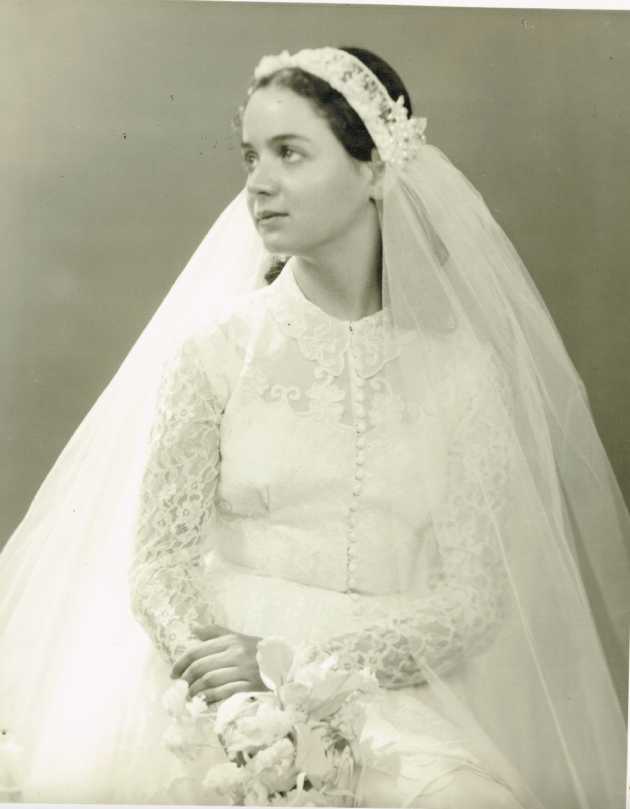
Malcah’s Closet
I want to tell you about my mother, but not about her being an artist, a free spirit, and bohemian. Not about her being kind, compassionate, generous and forgiving either. Or about how she raised me in a cloud of hazy and loving neglect, affording me the kind of freedom that was unheard of among the earnestly striving, aspiring Jewish families of our neighborhood.
No, I want to tell you about her clothes, and not just that they—and she—were glamorous and beautiful, but also that they were defining—to herself, to the world and to me.
I’ll begin with an outfit that she’s described but that I never saw, not even in photographs: a pair of Chinese-inspired green figured-silk pajamas with frog closures and cropped pants, worn with maroon leather flats. Inexplicably, it was the outfit she chose when she first showed up at Kibbutz Chatserim, in 1949. Those flats had such thin, delicate soles that she could feel every stone, every pebble on the rough, uneven path that led to the tent where my father awaited her arrival. What did the chalutzim, with their scuffed work boots, battered hats, and utilitarian shorts and shirts, make of her? I haven’t a clue.
The clothes that I did see are imprinted in my memories from the 1960’s and 1970’s—the years of my childhood and from a time when she was still young, having only been twenty-six when I was born. After the nine years she spent in Israel, first on a kibbutz and later on a moshav, she wasn’t at all interested in the highly groomed and tidily assembled look favored by the mothers of my friends. She eschewed their beauty parlors, hair spray and professional manicures. And while I was enchanted by the glossy finish these women presented, I was more dazzled by my mother’s inventive and original sense of style—she was the most bewitching of any of them. In the communal dressing room at Loehmann’s (a place whose flickering, fluorescent lights and punishingly hard benches smacked of the girls’ reformatory) I gazed raptly at the garments she elected to try, tentatively reaching out to touch a diaphanous sleeve, a glittering button, an embellished hem.
What did she bring home, what were the spoils of her hunt? A shimmery purple tunic, tied at the waist, which she wore with a pair of billowing, cherry velvet evening pants and several long strands of red crystal beads. A black-and-white checked wool coat with a black fox color, an Empire-waisted mini dress whose fetching green-and-white flowered print brought out the green of her eyes. There was also a sleeveless, square necked dress bisected by bold bands of color; its central motif was a target-like circle of red, black and white positioned right below the bust. And there was another sleeveless dress in a kind of denim-washed-blue cotton with a double row of red stitching at the neckline and hem. That one had a matching bow that she wore in her long, dark hair. Later there was a Mongolian curly lamb coat—so warm but so lightweight—the color of cafe au lait, a black jersey maxi dress she wore with an antique locket and cluster of chains, and another black dress, this one of linen, worn with a necklace of branch coral, an Italian navy silk with a pattern of orange and yellow shells that she wore under a vintage paisley silk cape.

Where are these clothes now? I wish I had them—to wear, to give to my daughter, to enshrine like the talismanic objects that they were, and still are. I have her jewelry—she favored turquoise, coral, amber, jade, Mexican silver, cameos of all sizes—and the dishes that she used to set the table, a convivial mix of Blue Willow, Blue Onion, and Flow Blue punctuated by the cobalt blue or ruby glassware that she collected, but of the clothing, there is barely anything.
Her wedding portrait shows her seated in a high necked, many-buttoned lace dress, a lace band framing her pure, saint-like face, her shoulders lightly grazed by her veil. That dress was the long ago casualty of a flooded basement in her parents’ home in Oak Park, MI before I ever had the chance to see or touch it.

But there is a single bit of finery that survives, and it makes up for its numerical paucity with a vivid memory in which I can see my mother, walking along a beach on the New Jersey shore, her normally cascading dark tresses tucked into a turban, her big dark glasses giving her a mysterious incognito. She’s wearing a hand-embroidered white caftan which my uncle, who followed her to Israel in the late 1940’s, obtained by trading several packages of American cigarettes. Before the full extent of the sun’s dangers were known, she would allow her naturally olive skin to tan to a rich, burnished brown. Against the white of the caftan, she seemed to glow, and as she made her way along the water’s edge, I saw people turning to look. To stare. In my eyes, she was a queen—her name was Malcah after all—and in summoning the memory, giving it shape and form, I feel as if I’m giving it back to her, a special gift. Happy Mother’s Day, is what I’ll say. God, but you wore it—all of it—so well.



